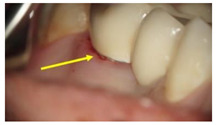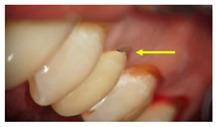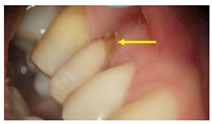Table 1.
Study groups and types of the prostheses used.
| Group | Description | Clinical Presentation |
|---|---|---|
| Group-I (n = 35) | Received a conventionally fabricated cobalt-chrome (Co-Cr) ceramic prosthesis; conventional wax up copings were converted to metal copings by the lost wax technique followed by porcelain layering. |

|
| Group-II (n = 30) | Received a Co-Cr ceramic prosthesis fabricated by a computer-aided design and computer aided manufacturing (CAD/CAM) using Sintron technology. Copings were milled from a soft pre-sintered Co-Cr alloy by CAD/CAM, sintered in a special oven and followed by porcelain layering. |

|
| Group-III (n = 30) | Received zirconia-based prostheses fabricated by the CAD/CAM technique. Zirconia was milled using the CAD/CAM system from pre-sintered zirconia blocks, sintered, and followed by porcelain layering. |

|
Arrows show the crown margins and gingival tissues interface.
